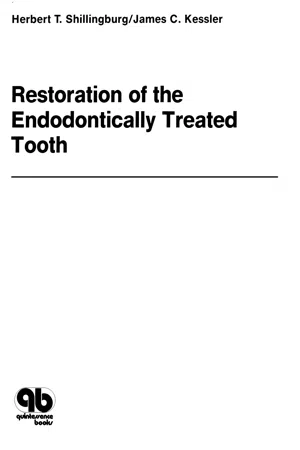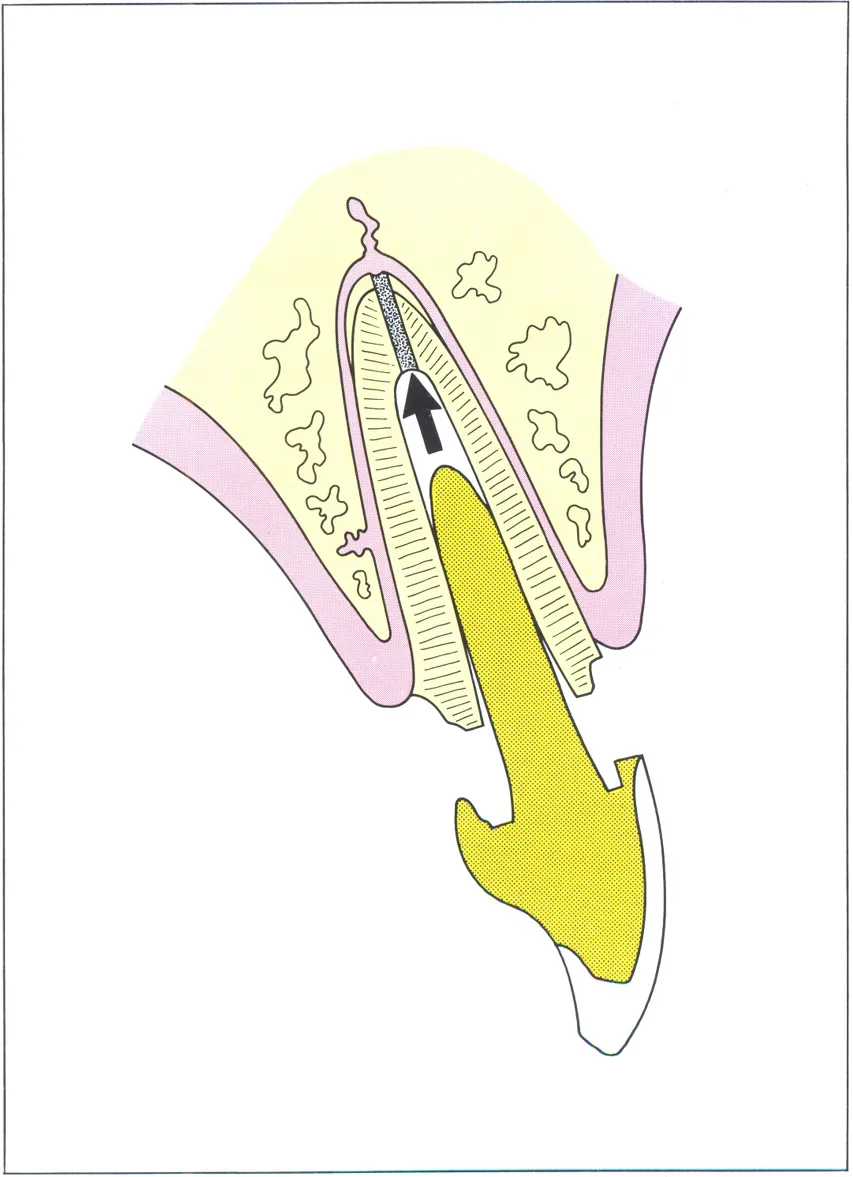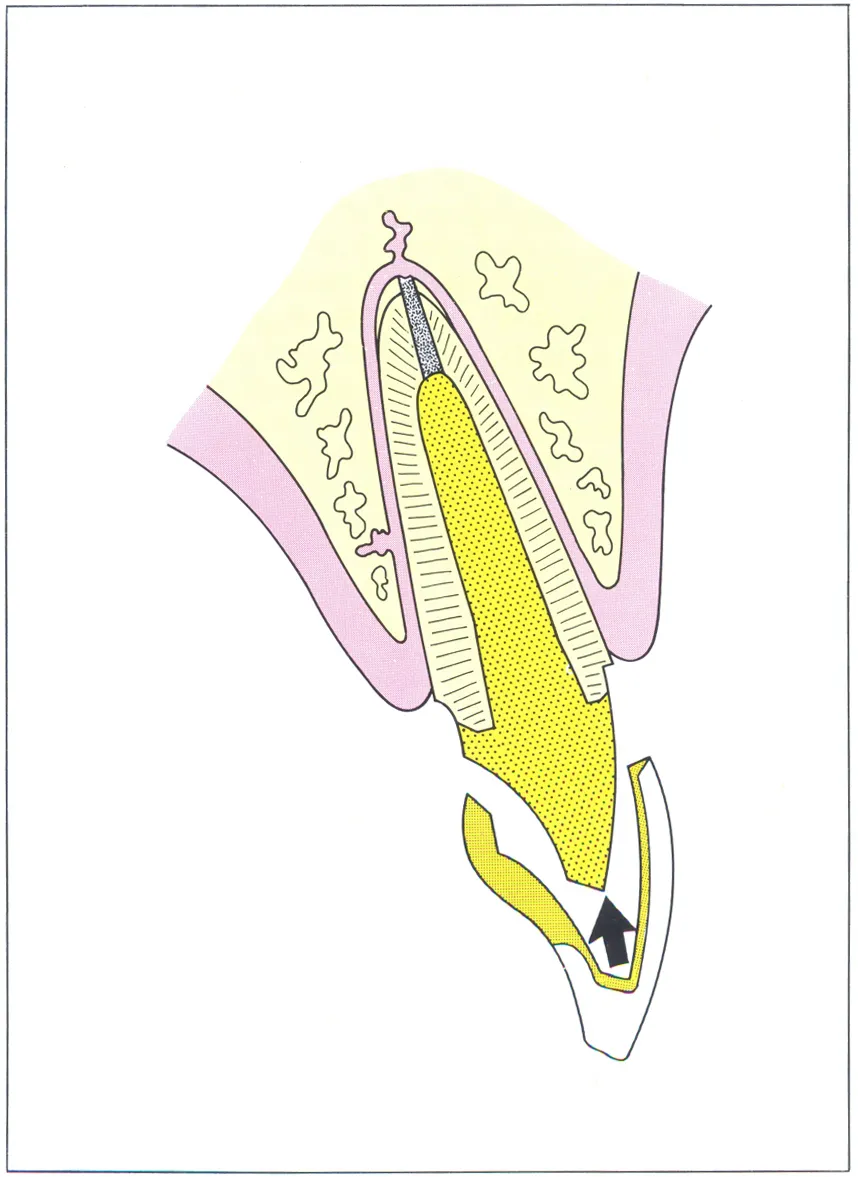
eBook - ePub
Restoration of the Endodontically Treated Tooth
This is a test
- 374 pages
- English
- ePUB (mobile friendly)
- Available on iOS & Android
eBook - ePub
Restoration of the Endodontically Treated Tooth
Book details
Book preview
Table of contents
Citations
About This Book
This atlas-style text demonstrates the uses of 14 types of dowel and pin-retained cores and explores the principles governing their selection for restorations of pulpless teeth. The use of endodontic therapy has spread within the profession. However, only when a tooth has been restored to function in a cosmetically acceptable way can endodontic treatment be considered complete. The text focuses on underlying principles and common aspects of restoration of endodontically treated teeth. As many different restorative techniques and systems are presented as possible for the reader's consideration.
Frequently asked questions
At the moment all of our mobile-responsive ePub books are available to download via the app. Most of our PDFs are also available to download and we're working on making the final remaining ones downloadable now. Learn more here.
Both plans give you full access to the library and all of Perlego’s features. The only differences are the price and subscription period: With the annual plan you’ll save around 30% compared to 12 months on the monthly plan.
We are an online textbook subscription service, where you can get access to an entire online library for less than the price of a single book per month. With over 1 million books across 1000+ topics, we’ve got you covered! Learn more here.
Look out for the read-aloud symbol on your next book to see if you can listen to it. The read-aloud tool reads text aloud for you, highlighting the text as it is being read. You can pause it, speed it up and slow it down. Learn more here.
Yes, you can access Restoration of the Endodontically Treated Tooth by Herbert T. Jr Shillingburg, James C. Kessler in PDF and/or ePUB format, as well as other popular books in Medicine & Dentistry. We have over one million books available in our catalogue for you to explore.
Information
Chapter 1
Principles of Restoration of Endodontically Treated Teeth
Restoration of the endodontically treated tooth is complicated by the fact that much or all of the coronal tooth structure which normally would be used in the retention of a restoration has been destroyed by caries, previous restorations, trauma, and the endodontic access preparation itself. The dentist must employ the principle of substitution, using a dowel in the root canal itself, or pins in the surrounding tooth structure, to build up a replacement for the missing coronal tooth structure. Only then can the tooth be restored.
Solutions to this problem have challenged the inventiveness and ingenuity of dentists for centuries. in fact, teeth were often intentionally devitalized so that the dentist could take advantage of the retention afforded by a dowel placed into the root canal. During the eighteenth century, Pierre Fauchard used a wooden post jammed into the canal to retain crowns. When the wood became wet, it swelled, making the fit even more snug and secure. It also, on occasion, split the root.
Early “pivot crowns” failed frequently because they were placed into poorly treated or totally untreated canals. The problem was such an obvious concern that one of the retentive devices, developed by Dr. F.H. Clark in 1849, consisted of a metal tube in the canal and a split metal dowel which was inserted into it.1 This “spring-loaded” dowel was so designed to allow for the easy drainage of suppuration from within the canal or apical areas!
Even G.V. Black tackled this problem by developing a porcelain faced crown held in by a screw inserted into a canal filled with gold foil.2 One design whose use persisted for a number of years was the Richmond crown. Introduced in 1880, it first consisted of a threaded tube in the canal which held a screw placed through the crown. This design was later simplified to eliminate the tube and make the dowel, by then unthreaded, an integral part of the final restoration or crown (Fig. 1-1).3–6

Fig. 1-1 At one time the dowel-crown, in which the dowel is an integral part of the crown, was a commonly used restoration design for restoring endodontically treated teeth. The Richmond crown is an example of this type.
With the increased interest in the restoration of pulpless teeth in recent years, there has been a gradual changeover from the crown in which the dowel is an integral part. In its place is a separate, well retained device which replaces the missing coronal tooth structure. The crown is fabricated over it as it would be fabricated over a preparation composed entirely of tooth structure (Fig. 1-2).

Fig. 1-2 The dowel-core utilizes a dowel in the root canal to retain the device, while the core portion replaces missing coronal tooth structure. The crown, a completely separate unit, is fabricated over the core as though it were a preparation in virgin tooth structure.
The supragingival portion of such a device, either because it replaces coronal tooth structure, or because it forms the center or core of the new restoration, or perhaps because of both, is referred to as a core. If it is retained by a dowel or post in the root canal, it is called a dowel-core. A third component of this system is an encircling band of metal which will support the tooth externally, bracing it against fracture by the dowel. This has been described as the “ferrule effect” by Eissmann, who suggests that it be 2.0 mm. wide.7 It may be provided by a coping,8 a long contrabevel on the core, or the axial walls of the crown, which extend apically beyond the margin of the dowel-core.
Finally, there must be a counter-rotational device on the dowel to prevent its being twisted or rotated by horizontal forces applied to the core. This can take the form of a keyway (a vertical groove cut in the wall of the canal, extending apically from the orifice),9–16 an ovoid or irregularly shaped canal,17–20 a short segment of a second root on a multi-rooted tooth,21 or a pin hole parallel with and separate from the canal preparation.22, 23 There is the possibility that the use of a keyway could endanger the structural integrity of the root.24 If a deep keyway is placed in a thin-walled tooth, it could act as a wedge and produce a cleavage plane. A keyway of normal depth and length placed in an adequate bulk of tooth structure is not likely to have a deleterious effect, however.
If the core is retained by small pins placed in the dentin around the root canal, it is a pin-retained core. Components may be prefabricated or custom-made, and they can be combined with cast metals or plastic material placed in the mouth. In any event, all devices used for building up teeth are variations of the dowel-core or the pin-retained core.
There are distinct advantages in having the retention device separate from the crown restoring the tooth. The adaptation of the axial walls and margin of the crown are totally unrelated to the fit of the dowel In the canal. Secondly, the crown can be easily remade if that should become necessary because of materials failure, caries, or change in the role of the crown (from simple restoration to bridge retainer) at anytime in the future. Rep...
Table of contents
- Cover
- About the Book
- Half Title Page
- Title Page
- Copyright Page
- Dedication
- Preface
- Acknowledgments
- Contents
- Chapter 1 Principles of Restoration of Endodontically Treated Teeth
- Chapter 2 Custom Dowel-Core (Direct)
- Chapter 3 Custom Dowel-Core (Indirect)
- Chapter 4 Custom Dowel-Core (Two-Piece)
- Chapter 5 Dowel-Core Under a Crown
- Chapter 6 Dowel-Inlay Crown Repair
- Chapter 7 Precision Parallel Plastic Dowel
- Chapter 8 Precision Tapered Plastic Dowel
- Chapter 9 Prefabricated Dowel/Cast Core
- Chapter 10 Prefabricated Dowel/Composite Resin Core
- Chapter 11 Parallel Threaded Dowel (Pretapped)
- Chapter 12 Parallel Self-Threading Dowel
- Chapter 13 Tapered Self-Threading Dowel
- Chapter 14 Amalgam Pin Core
- Chapter 15 Composite Resin Pin Core
- Chapter 16 Temporary Restorations for Endodontically Treated Teeth
- Authors Index
- Subject Index
- Series Page